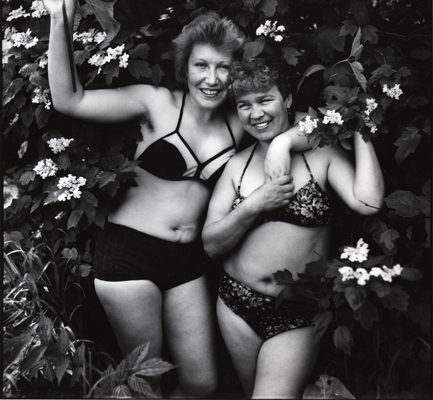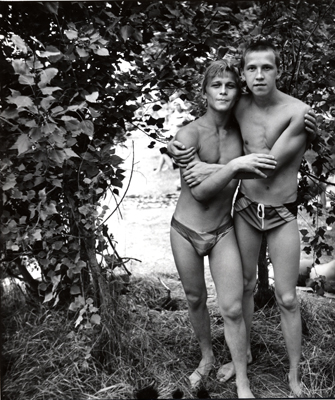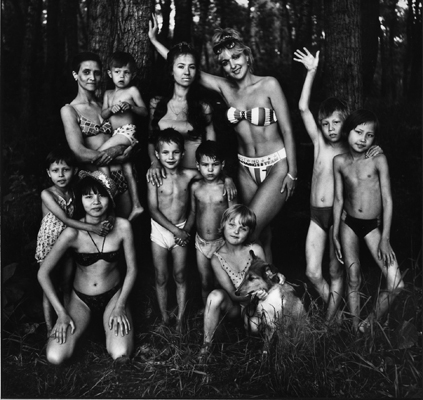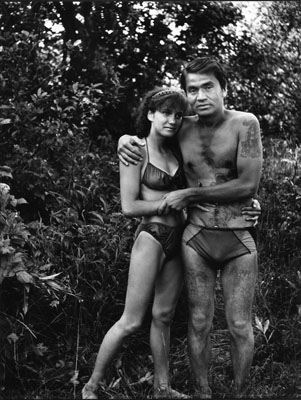Amateurs and Lovers: Nikolay Bakharev’s Gaze
Nikolay Bakharev: Public and Private, Gallery Photographer.ru, Moscow, November 29, 2008 – January 15, 2009
Nikolay Bakharev once photographed me and my adult daughter. We were part of a project initiated by a Moscow magazine. We were ready: we had gotten dressed up and we struck a pose, embracing against the white walls of my apartment. We hugged a bit more fervently than we would have for any other photographer: we knew that we were dealing with Bakharev. It was obvious that Bakharev sensed our discomfort. He went for the knockout punch: he chatted with us either in a shockingly familiar manner or quite rudely, attempting to provoke us. To his disappointment, we continued to behave as we would during any other professional photo shoot. There was no way we were going to undress, physically or emotionally. “Everyone in Moscow is like you,” the photographer remarked in irritation. “You all wear black.”
His models do not (usually) wear black and the walls of their dwellings are (usually) not white. They are usually undressed and resemble white spots amidst a flagrantly motley setting. They lay on patterned sofas, and behind them we see patterned wallpaper bedecked with rugs and reproductions of classical paintings. The floor is covered with linoleum, and the table is topped with an oilcloth. The entire scene is overloaded with decor. In front of the sofa there is a little table with the remains of a feast that, in all likelihood, the photographer took part in himself. It is a far cry from the professional relationship between the photographer and his passive subject that we expect.
Sometimes, the action unfolds not in an apartment, but in a park. The people are half-undressed all the same. They wear bathing suits and swimming trunks, and we might gather that they are sunbathing; that there is a lake or river nearby. But we see neither water nor open space, and the people are always photographed in the shade. It often appears that there is no sun here at all, and it is unclear why they got undressed: their nakedness seems like a comment on their souls, not their bodies. These people sit in little groups in the bushes, as if they are hiding. They seem to be in some kind of interior, an interior as cramped and dark as the apartments depicted in Bakharev’s photographs, where we never catch sight of either doors or windows. Married couples with their kids, large families, and large companies of friends – in the outdoors they touch one another with a frank tenderness. In their apartments, they are even franker, but even so, there is no clear line here between the eroticism of friendly intimacy and the eroticism of the bedroom.
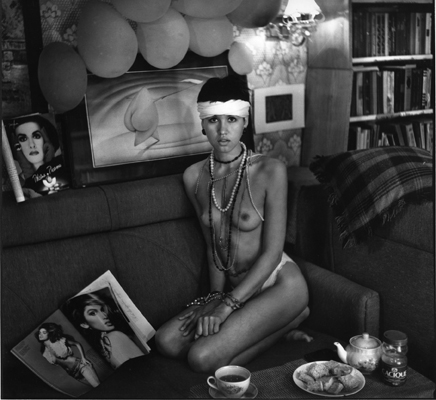
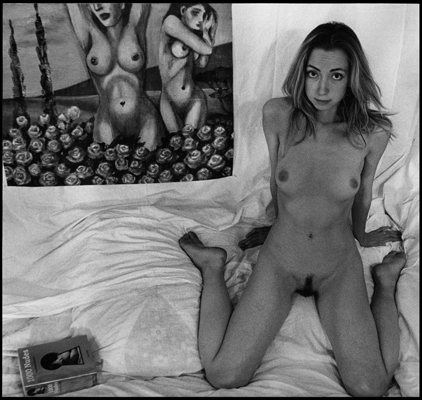 Taken in the waning days of Soviet civilization, these photos show us that, despite the notorious televised tirade, sex in the Soviet Union not only existed, but that there was nothing in the Soviet Union besides sex. Friendship was sex, work was sex, family was sex. There was nothing besides the kind of human intimacy that does not know how to gain distance on itself, to step back to that point from which one might cast a critical, dispassionate gaze. This dispassionate gaze is also missing from Bakharev’s works. The photographer is a part of the intimate world of his models. He is not a spectator, but someone who is alongside them. There is a sense of serenity in their gazes – no one here is measuring their bodies and faces against a social and aesthetic norm. This attitude toward the model is rooted in a social structure that rejected economic and psychological alienation. Bakharev’s photographs owe their existence to the flowering of amateur photography in the post-war communist Soviet Union, just like Boris Mikhailov’s earlier, now-classic photographs, which were taken in the sixties and seventies. They recorded the fact that photographer and model were members of a single collective, and this recording took place not in moments of work, but in moments of leisure in a Soviet Union that was filled with various forms of amateur art and recreation. Plump, middle-aged female athletes joyfully opened up to Mikhailov because he was one of them, someone for whom photography was a means of self-development, just as gymnastics was for them. Money did not come between them, and consequently, neither did alienation.
Taken in the waning days of Soviet civilization, these photos show us that, despite the notorious televised tirade, sex in the Soviet Union not only existed, but that there was nothing in the Soviet Union besides sex. Friendship was sex, work was sex, family was sex. There was nothing besides the kind of human intimacy that does not know how to gain distance on itself, to step back to that point from which one might cast a critical, dispassionate gaze. This dispassionate gaze is also missing from Bakharev’s works. The photographer is a part of the intimate world of his models. He is not a spectator, but someone who is alongside them. There is a sense of serenity in their gazes – no one here is measuring their bodies and faces against a social and aesthetic norm. This attitude toward the model is rooted in a social structure that rejected economic and psychological alienation. Bakharev’s photographs owe their existence to the flowering of amateur photography in the post-war communist Soviet Union, just like Boris Mikhailov’s earlier, now-classic photographs, which were taken in the sixties and seventies. They recorded the fact that photographer and model were members of a single collective, and this recording took place not in moments of work, but in moments of leisure in a Soviet Union that was filled with various forms of amateur art and recreation. Plump, middle-aged female athletes joyfully opened up to Mikhailov because he was one of them, someone for whom photography was a means of self-development, just as gymnastics was for them. Money did not come between them, and consequently, neither did alienation.
The situation Bakharev faced in the eighties was different. He and his models were involved in the semi-legal business of private portrait photography. Money (although the sums were probably modest) did come between them. It was this, however, that brought them together on the margins of society, creating an almost erotic sense of trust among the accomplices in this illegal form of micro-communism.
As in amateur photography, what is essential about these photographs is that they were originally not meant to be seen by strangers – only their subjects were supposed to see them. The shots were meant to exist as single prints; they were originals in the literal sense of the word. In this sense they were “authentic” art – that is, if we accept the notion that only a unique artifact that expresses the soul of its creator is art.
Paradoxically, it was post-war Soviet amateur photography that, despite its technical sophistication, cultivated the archaic notion of art (seemingly buried by the avant-garde) as the production of unique objects for contemplation. Their uniqueness was guaranteed by the strictness of Soviet censorship, which shut its eyes to the private production of art (including photography) provided that the artwork existed as a single specimen and did not leave the home of the artist or the model, even if it was erotic in character. This censorship was much more severe in those instances where the artist or photographer attempted to exhibit his work or distribute it in some other way. It is perhaps this fear of having one’s privacy violated (a fear that was genetically transmitted in the Soviet Union) that nowadays continues to impel many people to believe that the uniqueness and authorial individuality of the photograph is the guarantee of its artistry. Amateur in its motivations (that is, motivated by love, mood or sympathy), the photography of pretty still lives, landscapes, and children is perceived by the popular consciousness as the most artistic form of photography, contrasting favorably with newspaper photography or, even more so, with the critical photographic practice we find in contemporary art.
The Soviet utopia of universal amateurism, which unfolded as early as the thirties (the film Volga-Volga describes this phenomenon quite ironically) as it manifested itself after the war, was theoretically rooted in the avant-garde’s ideas of pure “creativity,” which it opposed to “commercial art.” In the event, however, this creativity did not pursue innovative, unprecedented forms; instead, it rang the changes on the most banal themes. Amateurs and originals, Bakharev’s characters are surrounded by an immense quantity of bad realist art and printed matter – pictures and calendars, newspaper clippings and magazine covers. As they dramatically grimace and pose, these characters diligently imitate these same images – be they ham-fistedly painted nudes or the photographs of Paloma Picasso – before our very eyes.
In fact, all this amateurism became art only when Bakharev, Mikhailov, and all the others who found and continue to find the strength in themselves to grow beyond amateurism, violated the vows of friendship, exited the confines of private life, and made – without the consent of their models – one extra print “for themselves.” That very same print having robbed the original, authentic human document of its uniqueness, is today exhibited not on motley wallpaper, but on white walls.


